by Bill Murray
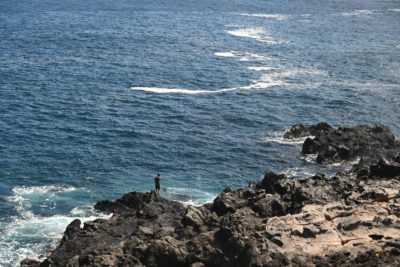 In the typical American city where we live, the average commute time is 78 minutes a day and 97.5% of these poll respondents agree traffic congestion is a serious problem. The last place you might expect to find people who commiserate is an island forty miles long and thirty wide, 420 miles east of Madagascar in the Indian ocean. But here we are.
In the typical American city where we live, the average commute time is 78 minutes a day and 97.5% of these poll respondents agree traffic congestion is a serious problem. The last place you might expect to find people who commiserate is an island forty miles long and thirty wide, 420 miles east of Madagascar in the Indian ocean. But here we are.
We came to poke around some of the more outre bits of Overseas France, La France d’outre–mer. Welcome to the French département of Réunion Island, eighteen hundred miles from Johannesburg and 3275 crow-fly miles south of India in the southern Indian Ocean. It doesn’t sound very French, but it is, resolutely, and likes it that way.
It’s about a four hour flight out here from Johannesburg, the only continental African connection. You leave late at night, think you can sleep a little bit but these aren’t long haul planes, so you do your best in a tilt-back seat. They do a quaint thing, they still run a food cart down the aisle handing out newspapers, like in the old days.
Time zones work to smooth out flight schedules, not sleeping schemes, so as you arrive, if you squint while you’re still way up in the air you can just discern that dawn, somewhere over the Andamans and Nicobars, is screaming around the planet, about to catch you.
And now that we’re here, we can’t get out of town. People are just crazy, crazy busy, but where is it they’re so busy getting off to? Réunion’s economic engine is sugarcane and its main exports are sugar, rum and molasses.
How does sugar cane make for highways filled with jostling commuters, heating, air conditioning and auto glass repair trucks? I’m hard pressed to believe all the Peugeots and Renaults darting around on the motorway need to be in quite the hurry that they are in support of the cane trade.
It’s peppy, zippy and busy around here. There are N1s and N2s, divided highways, tunnels and dramatic cable-stayed bridges along the coast road. Down the N1 from St. Denis, back up the N1 from St Paul. Some 60,000 vehicles travel between them and the port every day.
“It sometimes takes more than two hours to drives the 30 kilometres between the two cities,” sighs Gerald Victoire, a local trucker.
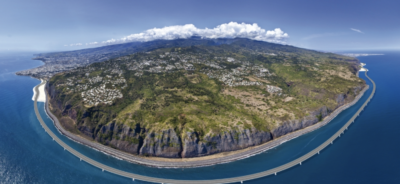
They’re finishing the world’s most expensive road here, twelve-plus kilometers that won’t be subject to rockslides since it’s 20 to 30 meters out over the sea.
Traffic in the middle of the ocean may be a metaphor for today’s frightening world, or the pointlessness of human striving, or at least for something, but still it’s kind of a thrilling thing to see.
I’m hugging the slow lane, I admit it, absorbing French salutes in my rear view mirror. I feel like one of the insufferable elderly Floridian drivers who summer in our north Georgia mountains. While they putter along the roads blocking our way we call them clueless and things less kind.
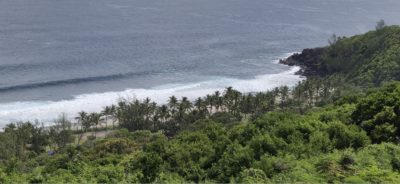
Eventually we find the solution: climb down off the motorway onto the coast road and yield to the languor of the beach.
The surf pounds so that you can feel it in your chest in the hotels we chose, even while you are inside, when the world grows quiet after dark. One hotel is okay, the other, the Palm, is surely one of the nicest properties anywhere.
If you are on Réunion Island and you summon Google Maps, it will show you the French mainland. That’s apt, for this is France, proudly, happy to be and serious about it.
St. Denis, the capital, is staging strikes in support of the big guys back home, against raising the retirement age. Even at a physical remove of fifty seven hundred miles, Réunion’s Frenchness looks non-negotiable.
•••••
It takes some flying to get out here, but a stay on Réunion is hardly the grim holidaymaking of package tourists less fortunate than the French, say, northern Europeans on package tours to Ibiza or Mykonos or Crete.
Les métropolitains Francais, the mainlanders, have an embarrassment of outstanding holiday options in their outre mer. There is Réunion, with its varied topography, its active volcano and its sharks, and there are the French Caribbean territories, New Caledonie and French Polynesia.
Réunion is not Africa. It’s vaguely grouped with Africa since, who else are you gonna group it with, and it has an eclectic group of neighbors.
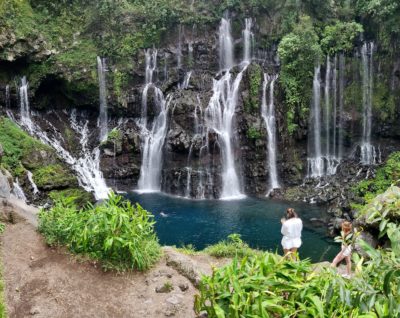
To the west is Madagascar, independent from France since 1960. As a general rule, coastal people there are descended from Africans, but in the highlands the largest ethnic group, the fairer almost olive-skinned Merina, descend from the Southeast Asian islands and/or Melanesia (the Melanesians are the same stock that later populated Rapa Nui, it’s thought).
There are flights listed on Réunion airport screens to holiday islands on Madagascar’s periphery, among them Nosy Be. I have never visited Nosy Be, but I know about it because my credit card was (unsuccessfully) charged for a stay at a resort there shortly after we once visited the Malagasy capital of Antananarivo.
Just over Réunion’s horizon, 200 kilometers northeast, lies Mauritius. It has spent time under Arab traders, the Portuguese, and later the Dutch, French and British. Nowadays Mauritius has a heavy Indian overlay. It’s a big holiday spot for the subcontinent and the only country in “Africa” where Hinduism is the most practiced religion.
While Réunion barrels along building roads and importing double it’s exports on Paris’s tab, things couldn’t be more different in the (relatively) nearby French département of Mayotte, part of the Comoros Islands archipelago. Much closer to the continental mainland than Réunion, opposite northern Mozambique, Mayotte and the Comoros are more closely tied to African ethnicity and culture.
Almost fifty years ago the islands held a referendum resulting in independence for the Comoros. Mayotte alone elected to stay French. As a result, while it’s still a poor place (it is “the poorest French department, with more than 80 per cent of its population living under the poverty line”) Mayotte has still drawn away from the rest of the Comoros islands in standard of living, healthcare resources and so on resulting in immigration from the other islands, so that now, about half of Mayotte residents are not citizens.
This produces periodic violence, including gang violence, and from time to time France threatens deportation of immigrants back to Comoros, and an overburdened Comoros resists. A military operation called Wuambushu (“take back”), involving troops sent from the French mainland, is ongoing just now.
The Outre Mer is having a couple of moments elsewhere, too. In French Polynesia this month, Agence France Presse reported on May first that

“Pro-independence parties lead by former French Polynesian President Oscar Temaru won the second round of territorial elections” last Sunday, and “this victory puts them in a strong position to negotiate a decolonisation process and a referendum on independence with the French government.”
And in New Caledonia, 2000 miles east of Australia, a vote against full independence is being contested because it was held during Covid, boycotted by some, and less than half the electorate voted.
•••••
The Portuguese saw value when they found the Azores in 1427, but they missed a trick by not putting down sticks in Réunion. They sailed here in the first years of the 16th century, but at the time their imaginations were fired by visions of conquest farther east, and they kept moving.
People think Réunion was largely uninhabited until the French arrived in the 1600s. They administered it from Mauritius. First they imported labor from places the most at hand, from East Africa and Malagasy. Over time they ventured farther afield and brought in Tamils, Gujarati Muslims and Chinese, resulting in the current French speaking creole.
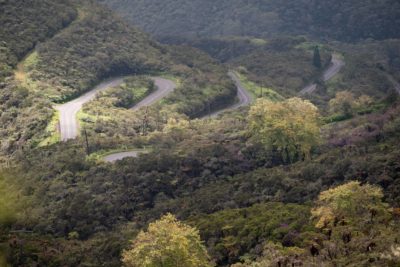
There are bits of La France d’outre-mer more outre than Réunion. Most of us know about the French Caribbean, French Guyana, French Polynesia and New Caledonia.
[One place evading radar and seeming content to keep it that way is St. Pierre et Miquelon, a small archipelago in the north Atlantic, the knowledge of whose existence seems to extend only to nearby Newfoundland. St. Pierre will be the subject of a future column.]
Farther afield than Réunion are Wallis et Futuna in the South Pacific (population twelve thousand) and Clipperton (an uninhabited rock in the eastern Pacific. There are the nominally French Southern and Antarctic Lands, French acronym TAAF, where a few dozen people live at a research station, and probably the most remote, the Kerguelen archipelago.
There was a day when the search for an imagined great southern land mass led explorers to some of the loneliest places on earth. Between Australia and South Africa is part of the planet virtually never seen, never really even thought about these days until that ghostly search for the missing Malaysian Airlines flight MH370.
Captain James Cook made his way over from the South Pacific, but French navigator Yves-Joseph de Kerguelen-Tremarec, coming from the other direction, beat him by four years. His discovery did not set the world on fire. The most useful plant his expedition found was a cabbage, the climate was atrocious, and Kerguelen didn’t even go ashore. Cook called them the Desolation Islands.
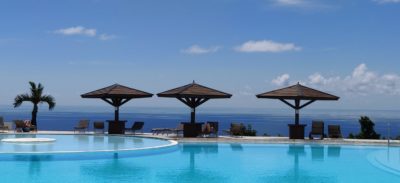
I once read on a fisherman’s blog that in Kerguelen, like in the Galapagos, evolution happens right before your eyes. There, butterflies have evolved without wings. Had they wings, it said, they would blow to sea. Instead they scurry between the rocks.
For the same reason there exists a wingless fly called Ana-Talanta Aptera. Flies without flight. Much of a fly’s energy is appropriated by its wings, so without them they need eat much less, and that is a boon in the Kerguelens.
It has been possible to visit the Kerguelen archipelago. Before Covid, there were berths for up to a dozen tourists on the supply ship that sails from Réunion four times a year. That was suspended during Covid and I’m unclear whether tourism has resumed. Berths cost around €9000 per person and the trip takes about 28 days.
•••••
Once you’ve made it all the way out to Réunion, do what everyone else does: get busy.
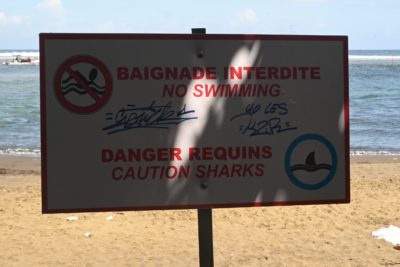
You should spend ample time on the lovely beaches, but don’t swim. There have been 22 fatal shark attacks in the last seventy years. Debris from flight MH370 washed up on the beach at Saint-André on the northeast coast in 2015, but don’t get the wrong impression about the beaches. They really are lovely.
You will eat. One cannot talk about France without French food and that’s true in the Outre Mer too. Not a bad meal in a week, even at a random stop along the beach, nowhere in particular, somewhere near St. Giles. In a gesture of supreme respect, my gauche American baseball cap comes off in restaurants.
There are hotels you choose from distant shores that, when you arrive, make your crest fall, plummet, even, but even at the slightly pompous and cloistered restaurant at the hotel on the hill, lunch was always lovely.
Where the Parisian mâitre d’ turns up his nose (along with his whiskers) and trades on hauteur, here the English language is exotic and having to deal with it over le menu flips the intimidation back onto le monsieur. Réunion rests at austral antipodes to Parisian disdain for English-speaking tourists. On Reunion, we’re interesting.
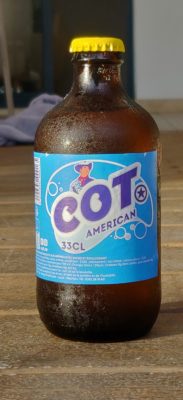
What the hell is Cot American? I’m not sure but it must be American; it has a cowboy hat on the label. It’s ghastly sweet, unlike us Americans.
No matter what else you do, you will drive. Rent yourself a Peugeot and hit the road. Drive up into the center of the island, because Réunion is also not France, given its tropical interior, complete with active volcano. We picked two places to explore, a lovely rock face of falling water in the south called Grand Galet, and the crater of the now dormant Piton des Neiges volcano, as seen from the viewpoint called Fenêtre des Makes, inland from St. Louis.
En route to the highest point on the island, Google Maps sent us into driveways, trench-protected turnarounds and such micro-local circumstances that finally we were scolded in French by an elfin loiterer, one of those guys you run into way out in the country just standing around like there’s nothing to be done the whole day long. By all observable data he was merely an idler, but who knows, maybe he was with the neighborhood patrol.
In my most optimistic imagining, perhaps he was urging us back to some visitor center we’d blustered past. Or maybe he’d made a pretty good call and decided we just belonged back on flat land. In a less kind light, he stood there in his chest high cane, up in our faces about driving down his street, where no damned foreigner had been since 1964.
In this case, as in most cases, our call was just to blunder on.
It was 8:00 a.m. at the top, all quiet in contrast to the nerve rattling belt road, and utterly quiet. A haze hadn’t quite yet, but meant to settle. Lower down I judged were cooking fires, making swirls like from a fresh lit cigar. They were dirty gray, not the lighter shade of fog. The first morning clouds around the peaks had yet to muster. It hardly felt like an island at all. The view was magnificent.

